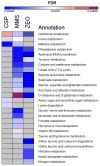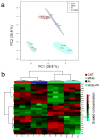Metabolic responses induced by DNA damage and poly (ADP-ribose) polymerase (PARP) inhibition in MCF-7 cells
- PMID: 26478723
- PMCID: PMC4606886
- DOI: 10.1007/s11306-015-0831-6
Metabolic responses induced by DNA damage and poly (ADP-ribose) polymerase (PARP) inhibition in MCF-7 cells
Abstract
Genomic instability is one of the hallmarks of cancer. Several chemotherapeutic drugs and radiotherapy induce DNA damage to prevent cancer cell replication. Cells in turn activate different DNA damage response (DDR) pathways to either repair the damage or induce cell death. These DDR pathways also elicit metabolic alterations which can play a significant role in the proper functioning of the cells. The understanding of these metabolic effects resulting from different types of DNA damage and repair mechanisms is currently lacking. In this study, we used NMR metabolomics to identify metabolic pathways which are altered in response to different DNA damaging agents. By comparing the metabolic responses in MCF-7 cells, we identified the activation of poly (ADP-ribose) polymerase (PARP) in methyl methanesulfonate (MMS)-induced DNA damage. PARP activation led to a significant depletion of NAD+. PARP inhibition using veliparib (ABT-888) was able to successfully restore the NAD+ levels in MMS-treated cells. In addition, double strand break induction by MMS and veliparib exhibited similar metabolic responses as zeocin, suggesting an application of metabolomics to classify the types of DNA damage responses. This prediction was validated by studying the metabolic responses elicited by radiation. Our findings indicate that cancer cell metabolic responses depend on the type of DNA damage responses and can also be used to classify the type of DNA damage.
Keywords: DNA damage; MCF-7; NMR; PARP; metabolomics.
Conflict of interest statement
Authors declare no competing financial interest.
Figures




Similar articles
-
Synthesis and Evaluation of a Mitochondria-Targeting Poly(ADP-ribose) Polymerase-1 Inhibitor.ACS Chem Biol. 2018 Oct 19;13(10):2868-2879. doi: 10.1021/acschembio.8b00423. Epub 2018 Sep 14. ACS Chem Biol. 2018. PMID: 30184433 Free PMC article.
-
Poly(ADP-ribose) Polymerase (PARP) and PARP Inhibitors: Mechanisms of Action and Role in Cardiovascular Disorders.Cardiovasc Toxicol. 2018 Dec;18(6):493-506. doi: 10.1007/s12012-018-9462-2. Cardiovasc Toxicol. 2018. PMID: 29968072 Review.
-
New perspectives on the plant PARP family: Arabidopsis PARP3 is inactive, and PARP1 exhibits predominant poly (ADP-ribose) polymerase activity in response to DNA damage.BMC Plant Biol. 2019 Aug 19;19(1):364. doi: 10.1186/s12870-019-1958-9. BMC Plant Biol. 2019. PMID: 31426748 Free PMC article.
-
The Poly (ADP-Ribose) Polymerase Inhibitor Veliparib and Radiation Cause Significant Cell Line Dependent Metabolic Changes in Breast Cancer Cells.Sci Rep. 2016 Nov 4;6:36061. doi: 10.1038/srep36061. Sci Rep. 2016. PMID: 27811964 Free PMC article.
-
Targeting PARP proteins in acute leukemia: DNA damage response inhibition and therapeutic strategies.J Hematol Oncol. 2022 Jan 22;15(1):10. doi: 10.1186/s13045-022-01228-0. J Hematol Oncol. 2022. PMID: 35065680 Free PMC article. Review.
Cited by
-
The effector AvrRxo1 phosphorylates NAD in planta.PLoS Pathog. 2017 Jun 19;13(6):e1006442. doi: 10.1371/journal.ppat.1006442. eCollection 2017 Jun. PLoS Pathog. 2017. PMID: 28628666 Free PMC article.
-
The Differential Metabolic Signature of Breast Cancer Cellular Response to Olaparib Treatment.Cancers (Basel). 2022 Jul 27;14(15):3661. doi: 10.3390/cancers14153661. Cancers (Basel). 2022. PMID: 35954325 Free PMC article.
-
Atovaquone: An Inhibitor of Oxidative Phosphorylation as Studied in Gynecologic Cancers.Cancers (Basel). 2022 May 5;14(9):2297. doi: 10.3390/cancers14092297. Cancers (Basel). 2022. PMID: 35565426 Free PMC article.
-
Metabolic alterations caused by the mutation and overexpression of the Tmem135 gene.Exp Biol Med (Maywood). 2020 Nov;245(17):1571-1583. doi: 10.1177/1535370220932856. Epub 2020 Jun 9. Exp Biol Med (Maywood). 2020. PMID: 32515224 Free PMC article.
-
The emerging relationship between metabolism and DNA repair.Cell Cycle. 2021 May;20(10):943-959. doi: 10.1080/15384101.2021.1912889. Epub 2021 Apr 20. Cell Cycle. 2021. PMID: 33874857 Free PMC article. Review.
References
Grants and funding
LinkOut - more resources
Full Text Sources
Other Literature Sources
Molecular Biology Databases
